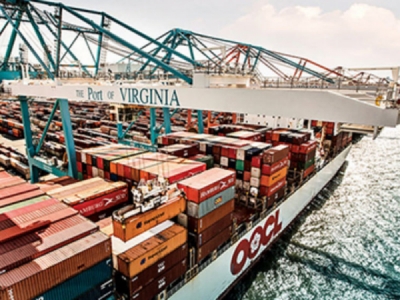
Posted on February 19, 2019
(Photo: Port of Virginia)
Ports of Virginia and Charleston put up strong numbers to start 2019, but regional Fed warns that slowdown could be approaching.
Ports in the southeastern U.S. are seeing record container volumes to start this year as their earlier expansion projects start paying off. The Port of Virginia reported that its container volumes for January were up 9 percent from a year ago, its highest January growth rate since 2017, reaching 240,111 twenty-foot equivalent units (TEUs). To the south, the Port of Charleston had its best January ever with 12.5 percent growth of container volumes, reaching 205,689 TEUs.
The ports are able to handle more volume thanks to projects they undertook to handle more cargo and relieve the congestion plaguing some of the larger U.S. import gateways. The Port of Virginia credits a $320 million project at the Virginia International Gateway that expanded truck gates, berth size, container stack yard and rail operations, enabling the facility to handle more freight.
With the project nearly complete, the Port of Virginia said the expansion brought down average truck turn times from just over 65 minutes at the Gateway to an average of 50 minutes. Virginia Port Authority CEO and executive director John F. Reinhart said the faster turn times for drivers “is the result of daily progress we’re making on our expansion projects – even as we continue to handle high volumes.”
For the Port of Charleston, it is crediting the investments made in inland ports for the growth in volumes. The South Carolina Ports Authority opened Inland Port Dillon last year to take containers from the Port to inland distribution centers via CSX (Nasdaq: CSX) rail service. Harbor Freight Tools is among the large shippers utilizing Port Dillon.
Port Dillon comes after the earlier success the SCPA had with its Inland Port Greer development, which now supports shippers such as Dollar Tree (Nasdaq: DLTR) and BMW. SCPA said Dillon’s January volume of 3,100 rail moves was the highest since its opening, while Port Greer’s 12,000 rail moves were the highest since 2017. “January was an exceptionally strong month for our Port, helping drive container volumes well ahead of our financial plans,” said Jim Newsome, SCPA president and chief executive officer.
The results mirror the latest outlook from economists at the Federal Reserve Bank of Richmond, which said the Southeast ports were seeing “robust activity” at the start of 2019. While auto exports appear to be softening, import volumes from China continue to rise due to orders being placed early to avoid possible tariff hikes.” But those volumes are likely to soften in the coming months, the economists warned. A survey of manufacturers in the Southeast said they were starting to see declines in shipments and new orders due to slowing global demand and seasonality.
This may be a year the dry bulk shipping industry would rather forget. The tragic disaster at a dam at Brazilian mine that left hundreds dead and missing took a major toll on iron ore shipments out of that country. Rates for shipping bulk commodities are at one of their lowest points in year. Now a major customer of the dry bulk shipping industry indicates 2019 could see overall demand decline.
Commodity trading firm Cargill, which operates about 570 ships, sees a host of factors working against dry bulk shipping this year. Eric Aboussouan, who heads Cargill’s research department, said on a conference call that it could take Brazilian miner Vale up to 12 months before it will return to normal export volumes following the mining disaster due to the number of inspections it will have to make at its mines. Vale said the disaster could take out about 10 percent of its expected production this year.
But iron ore is not the only commodity being impacted. Coal demand worldwide remains flat as the developed world weans itself off coal. China, the world’s biggest coal consumer, put import restrictions on coal used for making steel, which has also slowed ship transits. The ongoing trade war with the U.S. has also hit China’s appetite for soybean imports, which fell 8 percent last year.
“If you add all those three into ton-mile demand for 2019, you end up at best flat versus last year,” Aboussouan said. “I even think we can be slightly negative, which would be the first time for a very long time.”
But it’s not that shipowners do not have recourse when things get tough. Aboussouan said scrapping of older, less efficient ships will balance the market toward the end of the year. The trend will also be accelerated by the forthcoming regulations for reducing the sulfur output of ship’s fuel, which will favor newer, more fuel-efficient ships as well.
Source: Freight Waves





